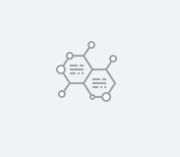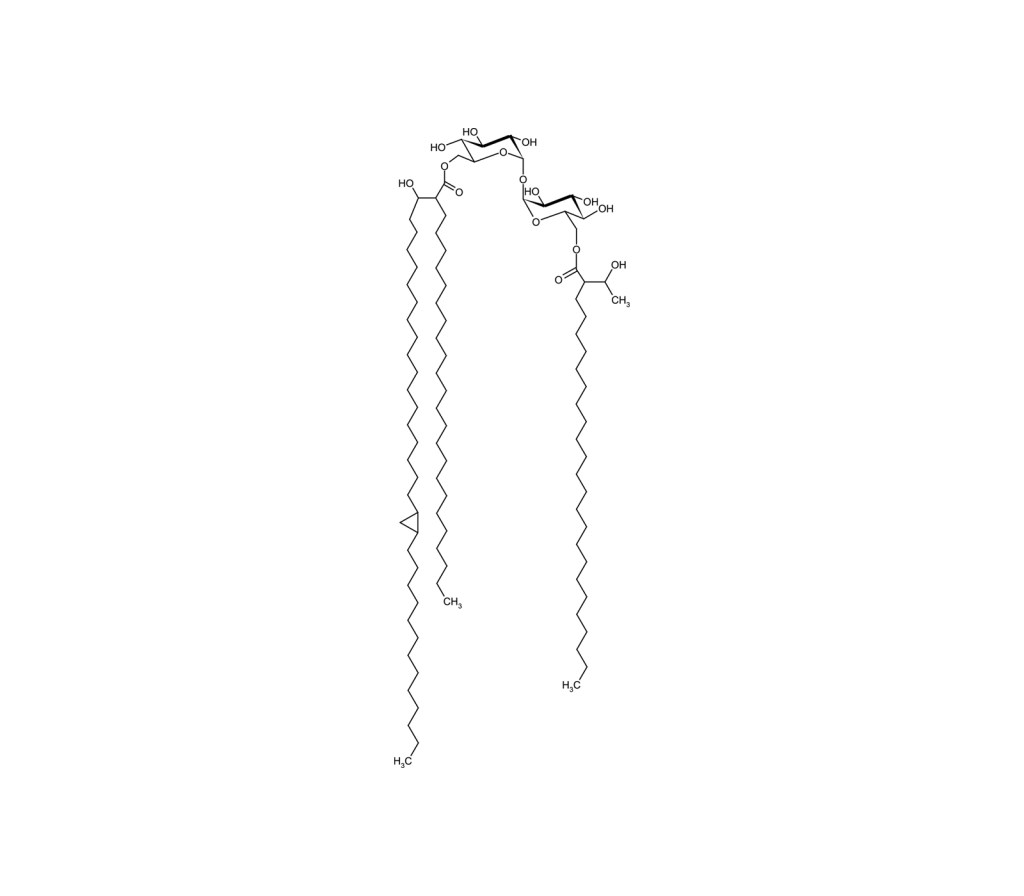Immunomodulator
Immunomodulatory compound / adjuvant. Induces activation of macrophages independent of TLR2 or TLR4.
Shipping: Available products typically ship within 24/48h, via priority shipping.
Do you need support? Contact Customer Service or Technical Support.
Online Account
Access or Create Your Account
Product Details
| Alternative Name |
Trehalose 6,6’-dimycolate, TDM, 6,6’-Di-O-mycoloyl-α,α-trehalose |
|---|---|
| CAS |
61512-20-7 |
| Formulation |
Lyophilized. |
| Purity |
Single spot (TLC) |
| Solubility |
Soluble in chloroform:methanol:water (90:10:1) (5mg/ml), hexane or isopropanol. |
| Source |
Isolated from Mycobacterium bovis, Bacillus Calmette Guérin. |
Handling & Storage
| Use/Stability |
As indicated on product label or CoA when stored as recommended. |
|---|---|
| Long Term Storage |
-20°C |
| Shipping |
Blue Ice |
| Regulatory Status |
RUO – Research Use Only |
|---|
- The NLRP3 inflammasome pathway is activated in sarcoidosis and involved in granuloma formation: Huppertz, C., Jäger, B., et al.; Eur. Respir. J. 55, (2020), Abstract
- USP15 Deubiquitinates CARD9 to Downregulate C-Type Lectin Receptor-Mediated Signaling: W. Xu, et al.; Immunohorizons 4, 670 (2020), Abstract — Full Text
- Development of ligand-coated beads to measure macrophage antimicrobial activities: T.T.B. Tram, et al.; Biol. Cell 111, 262 (2019), Abstract — Full Text
- MARCO variants are associated with phagocytosis, pulmonary tuberculosis susceptibility and Beijing lineage: N.T. Thuong, et al.; Genes Immun. 17, 419 (2016), Abstract
- Heat shock protein 90 inhibition abrogates TLR4-mediated NF-κB activity and reduces renal ischemia-reperfusion injury: S. O’Neill; Sci. Rep. 5, 12958 (2015), Application(s): In vitro experiment; Reagent , Abstract
- Macrophage scavenger receptor down-regulates mycobacterial cord factor-induced proinflammatory cytokine production by alveolar and hepatic macrophages: Y. Ozeki, et al.; Microb. Pathog. 40, 171 (2006), Abstract
- Interferon-gamma independent formation of pulmonary granuloma in mice by injections with trehalose dimycolate (cord factor), lipoarabinomannan and phosphatidylinositol mannosides isolated from Mycobacterium tuberculosis: H. Takimoto, et al.; Clin. Exp. Immunol. 144, 134 (2006), Abstract
- In vivo activity of released cell wall lipids of Mycobacterium bovis bacillus Calmette-Guerin is due principally to trehalose mycolates: R.E. Geisel, et al.; J. Immunol. 174, 5007 (2005), Abstract
- Requisite role for complement C5 and the C5a receptor in granulomatous response to mycobacterial glycolipid trehalose 6,6’-dimycolate: C.W. Borders, et al.; Scand. J. Immunol. 62, 123 (2005), Abstract
- Failure of CD1D-/- mice to elicit hypersensitive granulomas to mycobacterial cord factor trehalose 6,6’-dimycolate: T.V. Guidry, et al.; J. Interferon Cytokine Res. 24, 362 (2004), Abstract
- Cord factor trehalose 6,6’-dimycolate (TDM) mediates trafficking events during mycobacterial infection of murine macrophages: J. Indrigo, et al.; Microbiology 149, 2049 (2003), Abstract
- Influence of trehalose 6,6’-dimycolate (TDM) during mycobacterial infection of bone marrow macrophages: J. Indrigo, et al.; Microbiology 148, 1991 (2002), Abstract
- Mycobacterial glycolipid cord factor trehalose 6,6’-dimycolate causes a decrease in serum cortisol during the granulomatous response: J.K. Actor, et al.; Neuroimmunomodulation 10, 270 (2002), Abstract
- Immunological properties of trehalose dimycolate (cord factor) and other mycolic acid-containing glycolipids: R. Ryll, et al.; Microbiol. Immunol. 45, 801 (2001), Review, Abstract
- In vivo administration of mycobacterial cord factor (Trehalose 6, 6′-dimycolate) can induce lung and liver granulomas and thymic atrophy in rabbits: N. Hamasaki, et al.; Infect. Immun. 68, 3704 (2000), Abstract
- Extravascular coagulation and fibrinolysis in murine lung inflammation induced by the mycobacterial cord factor trehalose-6,6’-dimycolate: R.L. Perez, et al.; Am. J. Respir. Crit. Care Med. 149, 510 (1994), Abstract
- Development of a trehalose 6,6’-dimycolate model which explains cord formation by Mycobacterium tuberculosis: C.A. Behling, et al.; Infect. Immun. 61, 2296 (1993), Abstract
- Induction of resistance to tuberculosis in mice with defined components of mycobacteria and with some unrelated materials: E. Ribi, et al.; Immunology 46, 297 (1982), Abstract
- The chemical structure of the cord factor of Mycobacterium tuberculosis: H. Noll, et al.; Biochim. Biophys. Acta 20, 299 (1956), Abstract
Related Products
Monophosphoryl Lipid A from Salmonella minnesota R595 (Re) (TLRGRADE®) (Ready-to-Use)
ALX-581-202
TLR4 activator

| Alternative Name | MPL-A from Salmonella minnesota R595 (Re) |
|---|---|
| Couple Type | Activator, Ligand |
| Purity | ≥99.9% (regarding protein or DNA contaminants; KDO not detectable) |
Monophosphoryl Lipid A from E. coli, Serotype R515 (Re) (TLRGRADE®) (Ready-to-Use)
ALX-581-203
TLR4 activator

| Alternative Name | MPL-A from E. coli, Serotype R515 (Re) |
|---|---|
| Couple Type | Activator, Ligand |
| Purity | ≥99.9% (regarding protein or DNA contaminants; KDO not detectable) |
Last modified: November 25, 2024
Datasheet, Manuals, SDS & CofA
Manuals And Inserts
Specific Protocol
In vitro stimulation of macrophages
Purified Cord Factor was used to stimulate either mouse RAW 264.7 cells or bone marrow-derived macrophages. Cord Factor was suspended at a concentration of 1mg/ml in isopropanol and sonicated in a bath sonicator for 5 min. This suspension was incubated at 60°C for 10 min. and sonication repeated. The resulting solution was layered onto 24-well tissue culture plates at the indicated concentrations and incubated at 37°C in order to ensure complete evaporation of the solvent. Control wells were layered with solvent without Cord Factor and incubated at 37°C. To this layer of Cord Factor, either RAW 264.7 cells or bone marrow-derived macrophages were added at a concentration of 106 cells in 100µl of medium and incubated at 37°C for 24 hours before activation e.g. TNF-α production was measured in the supernatant.
Alternatively, Cord Factor was suspended at a concentration of 0.2 or 2mg/ml in hexane. Of the resulting solution 50µl were layered onto 96-well tissue culture plates at the indicated concentrations of 1 or 10µg/well, respectively and the solvent completely evaporated. Control wells were layered with solvent without Cord Factor and incubated at 37°C. To this layer of Cord Factor, either RAW 264.7 cells or bone marrow-derived macrophages were added at a concentration of 106 cells in 100µl of medium and incubated at 37°C for 24 hours before activation e.g. TNF-α production was measured in the supernatant.
In vivo pulmonary granuloma formation in mice
For in vivo experiments 10µg Cord Factor per mouse were applied i.v. in a water/oil/water emulsion.
Certificate of Analysis
Please enter the lot number as featured on the product label
SDS
Enzo Life Science provides GHS Compliant SDS
If your language is not available please fill out the SDS request form
 Lab Essentials
Lab Essentials AMPIVIEW® RNA probes
AMPIVIEW® RNA probes Enabling Your Projects
Enabling Your Projects  GMP Services
GMP Services Bulk Solutions
Bulk Solutions Research Travel Grant
Research Travel Grant Have You Published Using an Enzo Product?
Have You Published Using an Enzo Product?

